- Cover Letters
- Jobs I've Applied To
- Saved Searches
- Subscriptions
- Marine Corps
- Coast Guard
- Space Force
- Military Podcasts
- Benefits Home
- Military Pay and Money
- Veteran Health Care
- VA eBenefits
- Veteran Job Search
- Military Skills Translator
- Upload Your Resume
- Veteran Employment Project
- Vet Friendly Employers
- Career Advice
- Military Life Home
- Military Trivia Game
- Veterans Day
- Spouse & Family
- Military History
- Discounts Home
- Featured Discounts
- Veterans Day Restaurant Discounts
- Electronics
- Join the Military Home
- Contact a Recruiter
- Military Fitness

AGM-129 Advanced Cruise Missile
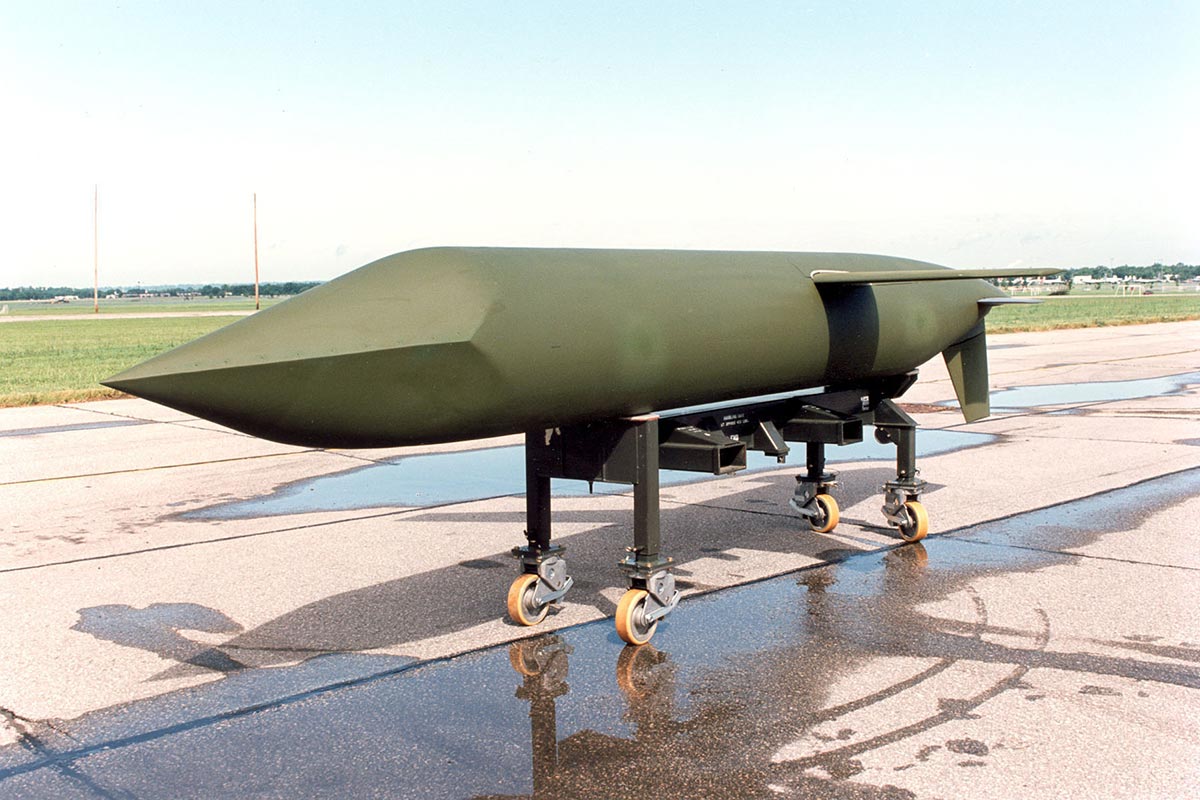
Contractor: Raytheon Missile Systems
Power Plant: Williams International Corp. F-112-WR-100 turbofan engine
Thrust: 700+ lbs
Length: 20 ft, 10 in
Weight: 3,500 pounds
Diameter: 29 in
Wingspan: 10 ft, 2 in
Range: 2,000+ miles
Guidance System: Inertial navigation with terrain contour matching and laser Doppler velocimeter updates
Warhead: Nuclear capable
The AGM-129A advanced cruise missile is a stealth, nuclear-capable cruise missile used exclusively by U.S. Air Force B-52H Stratofortress strategic bombers.
The AGM-129A is a subsonic, turbofan-powered, air-launched cruise missile. It is harder to detect, and has greater range and accuracy than the AGM-86 air-launched cruise missile. The ACM achieves maximum range through its highly efficient engine, aerodynamics and fuel loading. B-52H bombers can carry up to six AGM-129A missiles on each of two external pylons for a total of 12 per aircraft. When the threat is deep and heavily defended, the AGM-129 delivers the proven effectiveness of a cruise missile enhanced by stealth technology. Launched in quantities against enemy targets, the ACM's difficulty to detect, flight characteristics and range result in high probability that enemy targets will be eliminated.
The AGM-129A's external shape is optimized for low observables characteristics and includes forward swept wings and control surfaces, a flush air intake and a flat exhaust. These, combined with radar-absorbing material and several other features, result in a missile that is virtually impossible to detect on radar.
The AGM-129A offers improved flexibility in target selection over other cruise missiles. Missiles are guided using a combination of inertial navigation and terrain contour matching enhanced with highly accurate speed updates provided by a laser Doppler velocimeter. These, combined with small size, low-altitude flight capability and a highly efficient fuel control system, give the United States a lethal deterrent capability well into the 21st century.
In 1982 the Air Force began studies for a new cruise missile with stealth characteristics after it became clear that the AGM-86B would soon be too easy to detect by future air defense systems. In 1983 General Dynamics was awarded a contract to develop the new AGM-129A ACM. The first test missile flew in 1985; the first missiles were delivered to the Air Force in mid-1990.
Plans called for an initial production of approximately 1,500 missiles. The end of the Cold War and subsequent budget cuts led the Air Force to cease production after 460 missiles, with the final delivery in 1993. Several corporate changes during production resulted in Raytheon Missile Systems as the final production firm.
Equipment Categories
- Army Equipment
- Navy Equipment
- Air Force Equipment
- Marine Corps Equipment
- Coast Guard Equipment
- Military Aircraft
- Military Vehicles
- Personal Equipment
- Ships and Submarines
- Special Operations Equipment
Select Service
- National Guard
Latest Equipment Videos
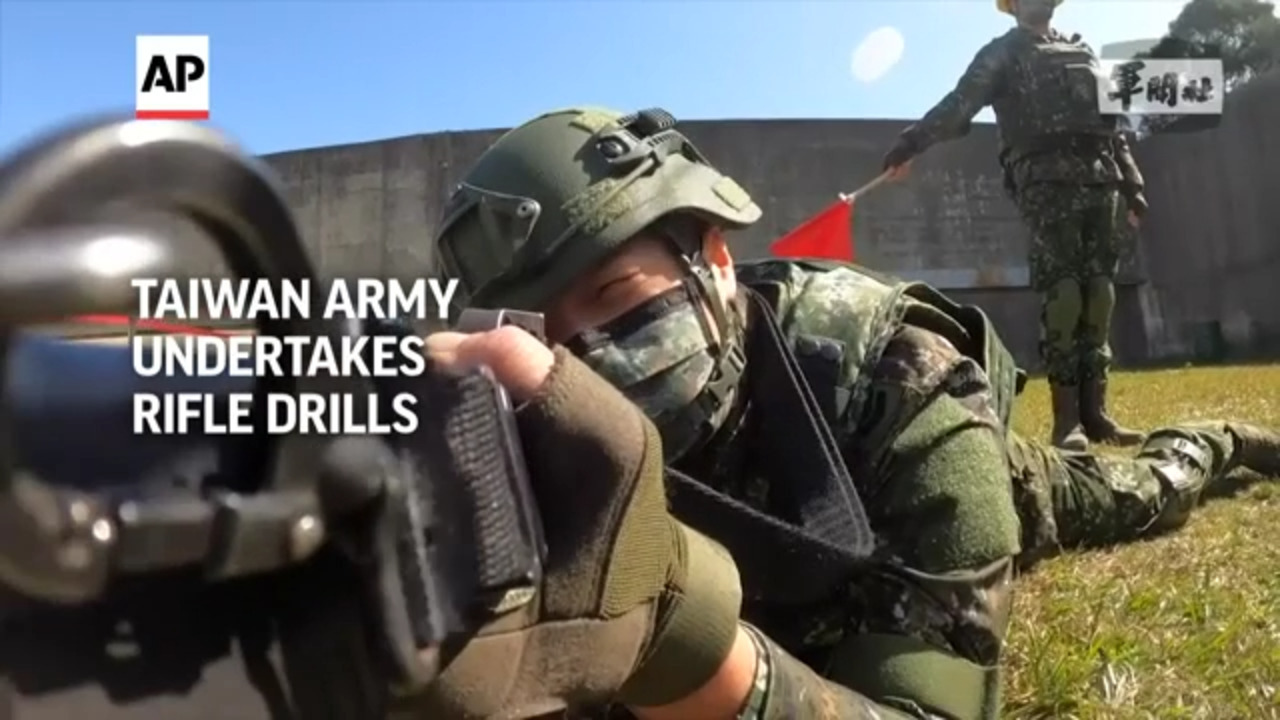
Taiwan’s Army demonstrated a new rifle training program Tuesday that is tailored to the needs of each local solider...

Boeing on Monday hosted a ribbon cutting for a new production area at NASA's Michoud Assembly Facility in New...
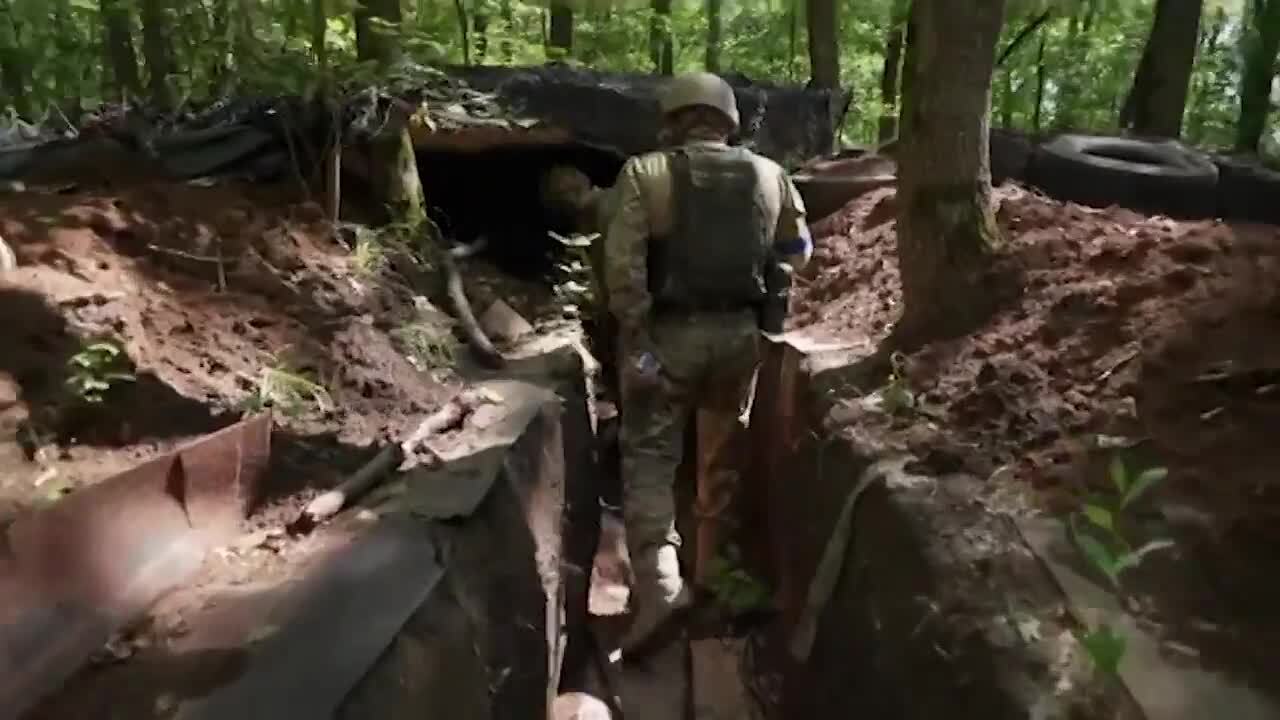
Ukrainian forces used self-propelled artillery in an effort to push Russian forces further away from the country's second largest...
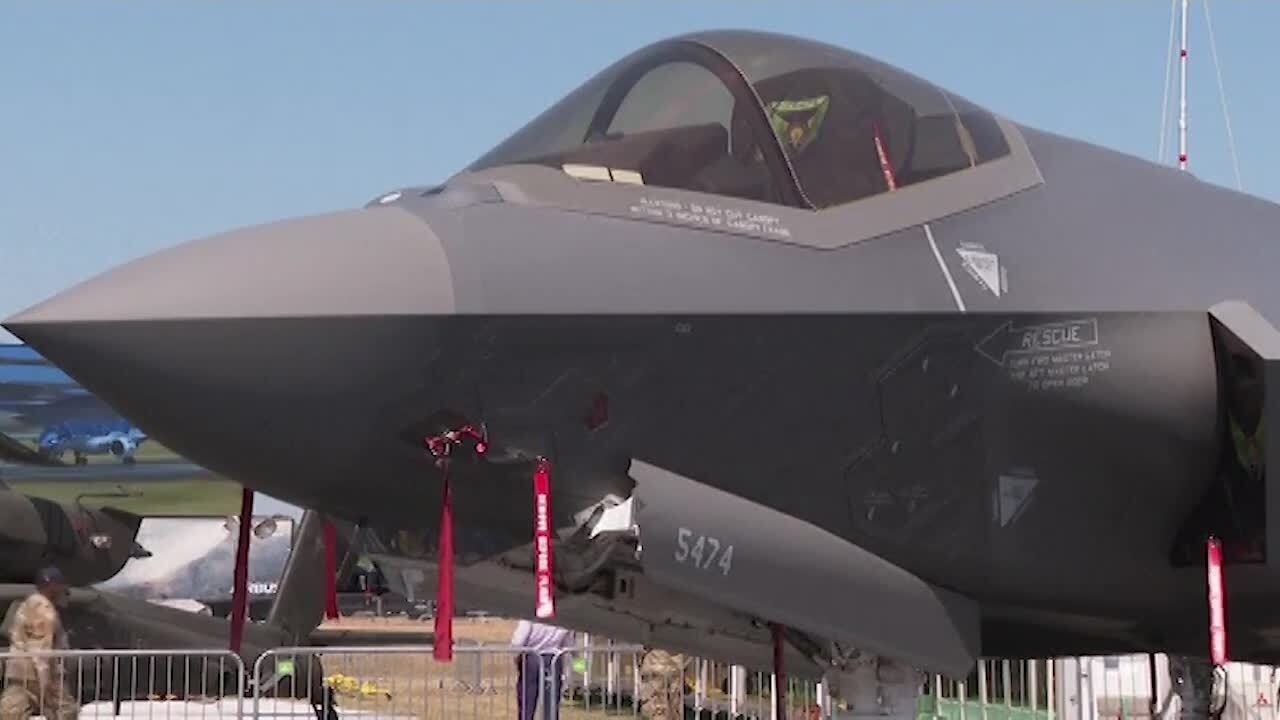
The real-life Top Gun pilots soar through the skies in F-35 fighter jets. These are billed as the most...

Ukrainian servicemen have been using American M777 howitzers on the battlefield as they seek to repel Russian forces in...
Military Technology
- Deadly Marine Osprey Crash Triggers Wrongful Death Lawsuit Against Bell Textron, Boeing, Rolls-Royce
- Another Dead End for Airborne Lasers: Air Force Scraps Effort to Mount Directed-Energy Weapon on Fighter Jet
- Marine Corps Says It Wants Counter-Drone Capabilities 'Yesterday' as It Rushes to Roll Out New Systems
- Air Force MQ-9 Crashed in Africa Last Year Due to Engine Failure, Report Details
Acquisition News
- Marines' New Amphibious Combat Vehicle Makes Operational Debut in Annual Philippines Exercise
- Air Force Wants to Send Historic Number of A-10s to the Boneyard in 2025, Continuing Shift Away from Warthogs
- The Rise and Fall of the Humvee
Guns & Gear
- The Best Deals on Shooting Gear on Amazon Right Now
- The Best Tactical Gear Deals on Amazon Right Now
- The Best Amazon Holiday Deals for Service Members, Veterans and Their Families
- The Best Military Watch Deals on Amazon Right Now
Latest Equipment News
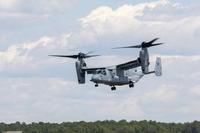
The lawsuit points to well-publicized issues with the Osprey's mechanics and names as defendants Bell Textron and Boeing...
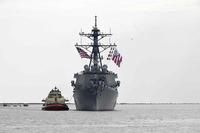
The USS Carney, the Navy destroyer that kicked off a period of intense fighting between U.S. ships and Houthi rebels...
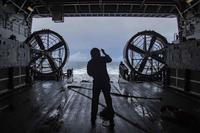
Two vessels called landing craft, air cushions, or LCACs, collided with each other on the night of May 1, resulting in 35...

Defense Secretary Lloyd Austin committed to keeping U.S. weapons moving to Ukraine as Kyiv faces one of its toughest moments...
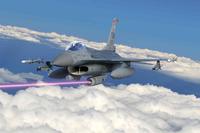
The Self-Protect High-Energy Laser Demonstrator, or SHiELD, was envisioned as a laser weapon mounted on fighter jets such as...
FAS | Nuke | Guide | USA | Bomber |||| Index | Search |
Agm-129 advanced cruise missile [acm].

Sources and Resources
Let Your Curiosity Soar
Agm-129a advanced cruise missile.
The AGM-129A was a subsonic, turbofan-powered, air-launched cruise missile. It was harder to detect and had greater range and accuracy than the AGM-86 Air-Launched Cruise Missile (ALCM). B-52 bombers could carry up to six AGM-129A missiles on each of two external pylons for a total of 12 per aircraft . Launched in quantities against enemy targets, the ACM’s difficulty to detect, flight characteristics and range resulted in the high probability that enemy targets would be eliminated. The AGM-129A saw service from 1990 to 2002.
Additional Exhibits
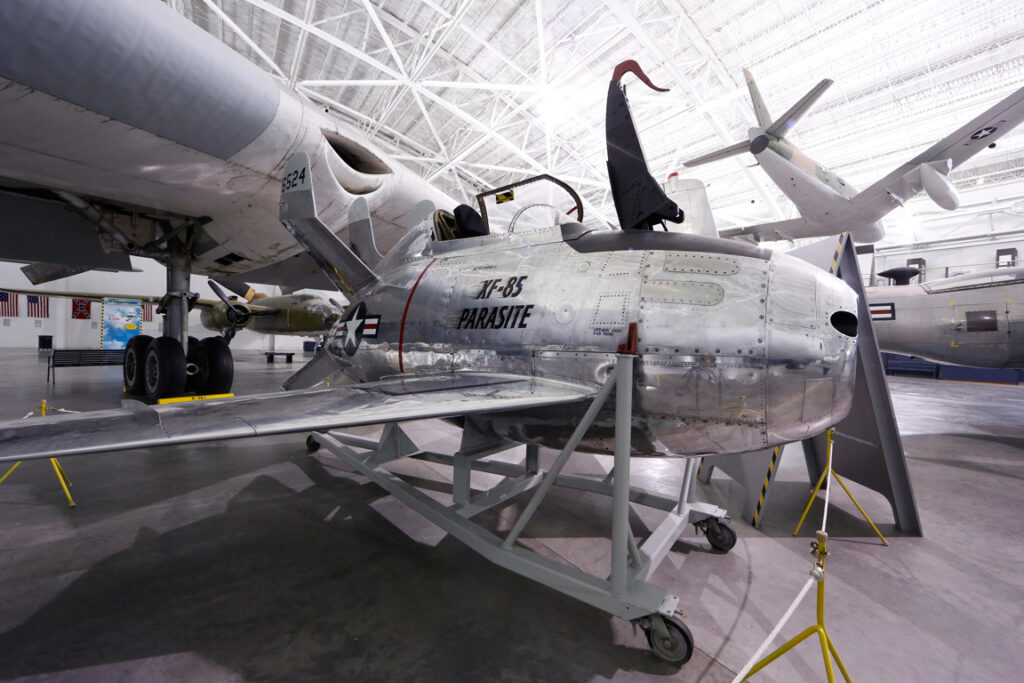
XF-85 “Goblin”
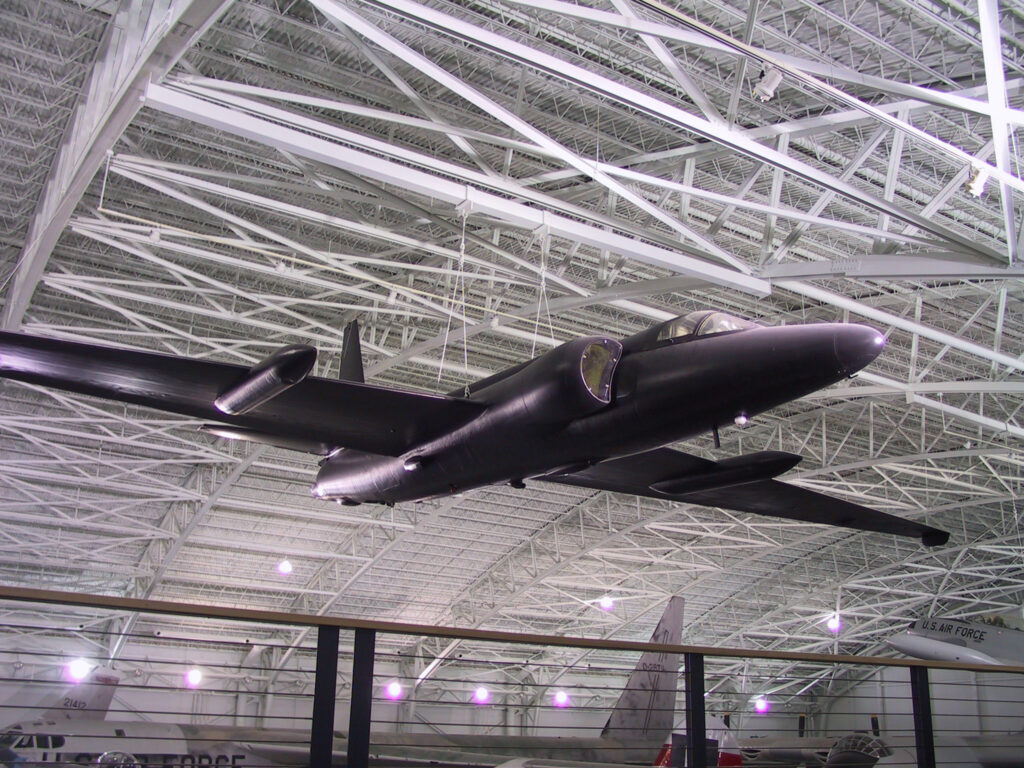
U-2C “Dragon Lady”
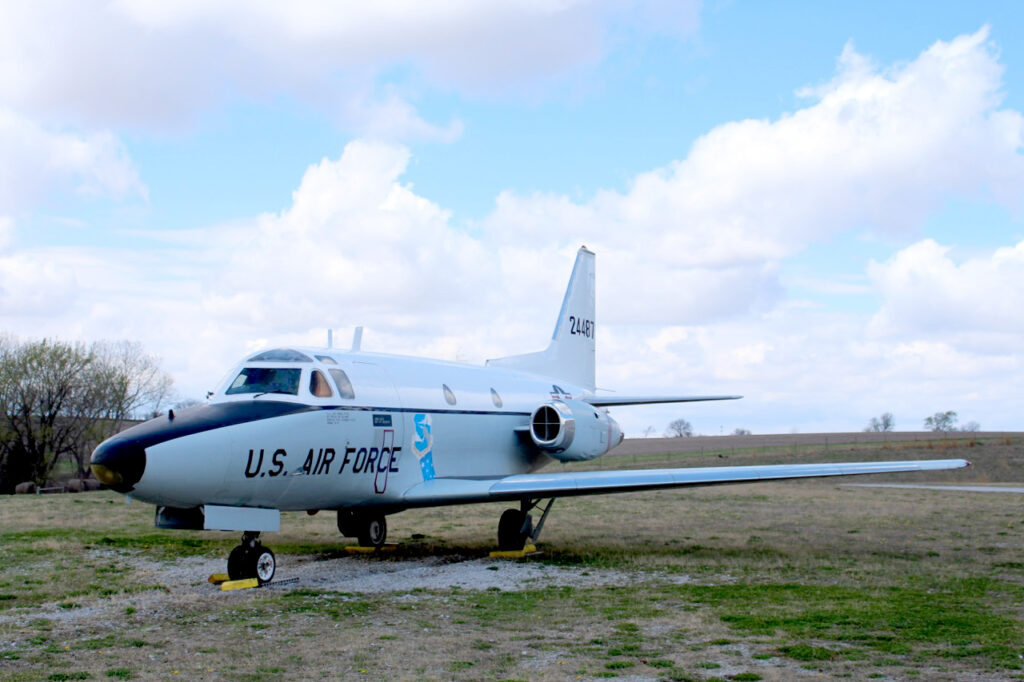
T-39A “Sabreliner”
(e.g. [email protected])
Remember me
Forgot Password?

- SECRETARY OF DEFENSE LLOYD J. AUSTIN III
- Combatant Commands
- Holiday Greetings Map
- Taking Care of Our People
- Focus on the Indo-Pacific
- Support for Ukraine
- Value of Service
- Face of Defense
- Science and Technology
- Publications
- Storytellers
- Tell Your Story
- Media Awards
- Hometown Heroes
Hometown News
- Create Request
- Media Press Kit

- DVIDS DIRECT
Media Requests
About dvids.
- Privacy & Security
- Copyright Information
- Accessibility Information
- Customer Service
Tinker Celebrates 75 Years: Raytheon AGM-129A ‘ACM’ missile profile

Photo By Greg L. Davis | General Dynamics AGM-129 Advance Cruise Missile on display with wings out as if... ... read more read more
Photo By Greg L. Davis | General Dynamics AGM-129 Advance Cruise Missile on display with wings out as if in-flight in the Charles B. Hall Memorial Air Park on Feb. 16, 2017, Tinker Air Force Base, Oklahoma. Tinker AFB maintains not only aircraft, but also cruise missiles and their components. (U.S. Air Force photo/Greg L. Davis) see less | View Image Page
OKLAHOMA CITY, OK, UNITED STATES
Story by greg l. davis , 72nd air base wing.
Tinker AFB, Okla.--The Convair/General Dynamics/Raytheon AGM-129A Advanced Cruise Missile was an air-launched, high-subsonic capable missile developed for employment with Air Force manned bomber programs. The ACM was designed to supplement AGM-86B Air-Launched Cruise Missiles already in use and first flew in 1985. Initial deliveries of AGM-129A ACMs to Air Force stocks took place by mid-1990. The last of 460 examples was delivered in 1993, marking a relatively short production run for a weapon system of this type. Originally slated for use by both the B-52G/H Stratofortress and B-1B Lancer, the missile would only be fielded with the B-52 fleet at Barksdale Air Force Base, Louisiana and Minot AFB, North Dakota. Each B-52 was capable of carrying six ACMs on two underwing pylons for a total of twelve AGM-129As per aircraft. Tinker’s role with the AGM-129A came through engine maintenance and sustainment operations. The Williams International F112-WR-100 turbofan has a high thrust to weight ratio and produced over 700 pounds of thrust. Organic sustainment operations for the F112 began on July 23, 1991, when a depot maintenance line was activated within the Oklahoma City Air Logistics Center. During the missiles service life there were 552 inputs to the F112 line between 1991 and 2002, according to Tinker history documents. The ACM was the Air Force’s first missile to incorporate stealth design elements such as angular surfaces, radar-absorbent material, a flush-mounted jet intake and flat exhaust hidden near the tail. These features reduced the radar signature to make the missile hard to detect by enemy radar and therefore hard to defend against by the associated air-defense systems. Forward-swept, switchblade like wings were deployed from their stowed (carry) position within seconds after release by the B-52. An incredible range of over 2,000 miles was possible through the use of precision guidance inertial navigation and terrain contour matching systems, along with a highly efficient engine and associated fuel management system. Each missile was 20 feet, 10 inches long, had a 10 foot wingspan and weighed more than 3,500 pounds. The ACM was equipped with a W80-1 nuclear warhead with 5-150 kiloton yield. During its service life the ACM-129A was one of two nuclear capable air-launched missiles in use by the Air Force, but the only with stealth characteristics. The expected service-life of 2030 was abruptly cut short for the ACM when funding was removed from the fiscal 2008 budget to meet reduction of nuclear warhead treaty agreements made with Russia in the previous years. Manufacturer: Convair/General Dynamics/Raytheon Missile type: AGM-129A Nickname: ACM Power plant: Williams International F112-WR-100 turbofan engine In-service dates: 1990-2008 Number produced: 460 Tinker connection: Engine maintenance and sustainment

LEAVE A COMMENT
Public domain .
This work, Tinker Celebrates 75 Years: Raytheon AGM-129A ‘ACM’ missile profile , by Greg L. Davis , identified by DVIDS , must comply with the restrictions shown on https://www.dvidshub.net/about/copyright .
CONNECTED MEDIA

MORE LIKE THIS
Controlled vocabulary keywords.
No keywords found.
- Register/Login to Download
DVIDS Control Center
- 404-282-1450
- [email protected]
Web Support
- [email protected]
- 1-888-743-4662
- Links Disclaimer
- No FEAR Act
- Small Business Act
- Open Government
- Strategic Plan
- Inspector General
- Sexual Assault Prevention
- DVI Records Schedule
- DVI Executive Summary
- Section 3103

Raytheon (General Dynamics) AGM-129 ACM
The AGM-129 ACM (Advanced Cruise Missile) is a stealthy, nuclear-armed cruise missile used exclusively by B-52H Stratofortress strategic bombers. It was originally planned to completely replace the AGM-86 ALCM , but limited funding led to the procurment of less than 500 missiles.
USAF studies for a new cruise missile with stealth characteristics began in 1982, when it became clear that the AGM-86 ALCM would become too easily detectable by future advanced air-defense systems. In 1983, General Dynamics was awarded the development contract for the new AGM-129A ACM . The first test missile flew in July 1985, and in June 1990, the first production missiles were delivered to the USAF.
The AGM-129A is powered by a Williams F112 turbofan engine, and armed with the same W-80-1 variable-yield thermonuclear warhead as the AGM-86B ALCM . Its external shape is optimized for LO (Low Observables) characteristics and includes forward-swept wings and tailplanes, a flush air intake, and a flat shielded jet exhaust. For guidance, the ACM uses an inertial navigation system together with a TERCOM (Terrain Contour Matching) system. The accuracy is quoted between 30 m (100 ft) and 90 m (300 ft), but it is highly likely, that the operational missiles were upgraded with GPS receivers for further enhanced accuracy. Range of the AGM-129A is also significantly higher than that of the AGM-86B. Alhough the ACM was originally intended for the B-1B, it is now deployed only by the B-52H. A cruise-missile configured B-52H can carry up to 20 ACMs , eight on the internal rotary launcher, and 12 on two underwing pylons.
Original plans called for the production of up to 2500 AGM-129 missiles, but this total was soon reduced to 1460 and later to 1000. Like many other weapon programs, the ACM was affected by the end of the Cold War. In 1992, the USAF announced to halt production of the missile after 460 rounds, and the last one was delivered in 1993. Current prime contractor for all AGM-129 activities is Raytheon Missile Systems Co.
There was also a projected AGM-129B version of the ACM . The official source [3] describes it as an "AGM-129A modified with structural and software changes and an alternate nuclear warhead for accomplishing a classified cruise missile mission." Apart from that, no further information is available, but most likely no ACMs were completed as AGM-129Bs. Reports, which attribute the AGM-129B designation to a planned, but eventually not funded, non-nuclear version of the ACM are erroneous. While a conventionally armed ACM was indeed proposed to the USAF by General Dynamics (and unofficially referred to as "AGM-129C"), this proposal was turned down.
In March 2007, the USAF announced that it will retire its entire stockpile of AGM-129 missiles (most likely until some time in 2008).
Specifications
Note: Data given by several sources show slight variations. Figures given below may therefore be inaccurate!
Data for AGM-129A :
Main Sources
[1] James N. Gibson: "Nuclear Weapons of the United States", Schiffer Publishing Ltd, 1996 [2] Hajime Ozu: "Missile 2000 - Reference Guide to World Missile Systems", Shinkigensha, 2000 [3] "DOD 4120.15-L: Model Designation of Military Aerospace Vehicles", Department of Defense, 1990
Back to Current Designations Of U.S. Unmanned Military Aerospace Vehicles Back to Directory of U.S. Military Rockets and Missiles
The Saga Of The AGM-129 Cruise Missile That Was Basically A Stealth Jet Designed Upside Down
The Advanced Cruise Missile was too far ahead of its time, so much so that it was eventually succeeded by the missile it was supposed to replace.

Aviation_Intel
Most people would be surprised to hear that the most advanced nuclear-tipped cruise missile ever put into operation was retired from service while its predecessor, a less survivable missile it was supposed to replace, soldiers on in U.S. Air Force service to this very day. This topsy-turvy reality is somewhat metaphorical of General Dynamics' AGM-129 Advanced Cruise Missile (ACM) itself. In fact, the AGM-129 could be considered the second stealth aircraft to ever enter production, because that is what it really was, albeit one that was designed upside down, and for good reason.
The origins of the ACM are fairly straightforward. The AGM-86B Air-Launched Cruise Missile (ALCM) entered service in the early 1980s. When it was being designed, and while the non-production AGM-86A was undergoing initial trials, the best way to deliver a nuclear warhead deep inside Soviet airspace by an air-breathing platform was via low-altitude penetration . The AGM-86 was designed exactly for that, to punch through at treetop level using terrain contour matching , terrain-following radar, and inertial navigation to get close enough to a target that the W80 nuclear warhead onboard could do its job successfully.
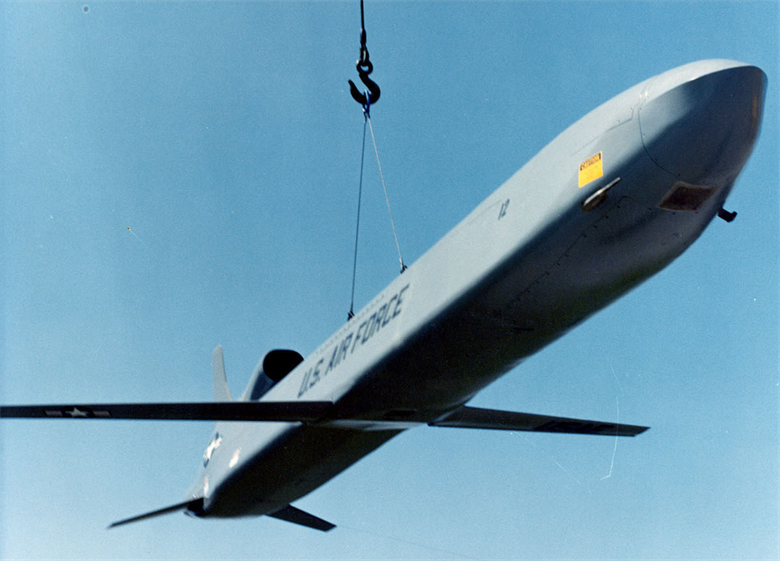
Later on, the AGM-86C and D would integrate GPS to deliver pinpoint conventional strikes. You can read all about the AGM-86C/D's capabilities in this recent piece of ours , but the nuclear-armed version of the era had no such accuracy. Regardless, survivability against quickly evolving Soviet air defenses was the most pressing requirement in the Air Force's air-launched cruise missile portfolio as the 1970s gave way to the 1980s.
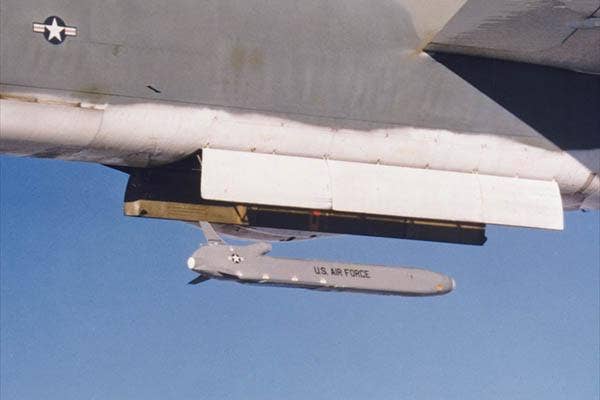
The AGM-86B had a few stealthy characteristics, but it was far from a true low observable design. Just as it came into service, the Air Force realized that the days when being able to beat air defenses via low-flying alone were coming to an end. Airborne early warning and control aircraft and advanced fire control radars with look-down-shoot-down capabilities, like those on Russia's 4th generation fighter and interceptor fleets (Su-27 and MiG-31, specifically), would decrease the effectiveness of nap-of-the-earth flying tactics. Something far more survivable was needed, and fast.
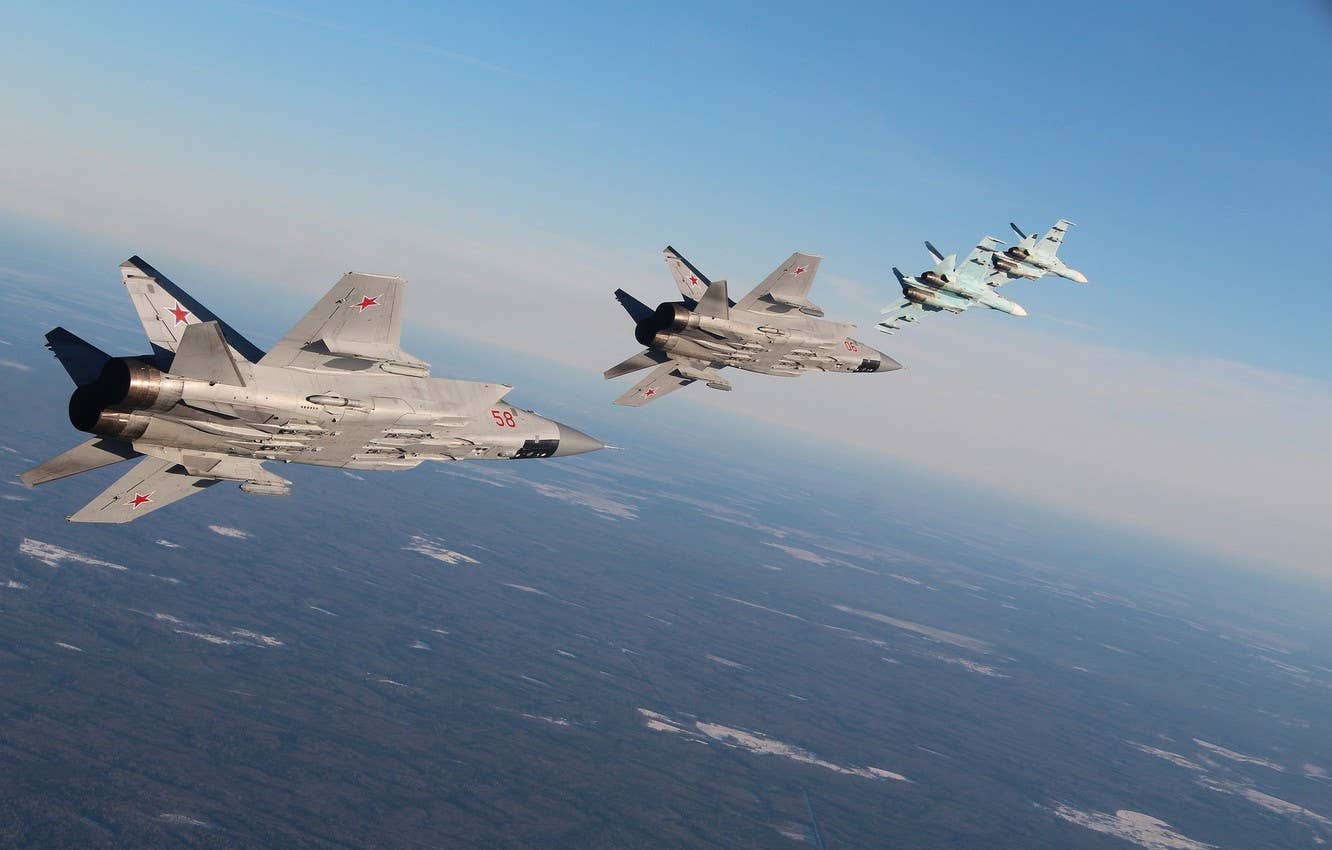
Out of a handful of DARPA initiatives and studies dubbed TEAL DAWN that explored future cruise missile technologies and long-range bomber strategies, it was concluded that the new stealth bomber then in development alone wouldn't be survivable against the densest Soviet air defenses. Long-range and survivable standoff weapons would be needed in part to mitigate those defenses. Two requirements were established—one stealthy missile that could travel around 1,500 miles or more and another that could travel over 5,000 miles. The latter clearly invalidated much of the need for a stealth bomber in the first place and it was thought that at least a decade would be needed to develop such a long-range weapon. As a result, it was jettisoned to concentrate on the shorter-ranged stealthy cruise missile requirement that could be fielded quickly and equip the Air Force's new stealth bomber—at least that's what they hoped. With this in mind, a competition to build such a weapon was quietly launched.
Lockheed, Boeing, and General Dynamics ended up squaring off in secret for this new contract. Lockheed's Skunk Works leveraged their work on the F-117 program, which was just spinning up in a very secretive operational state at the time , to produce its F-117-shaped cruise missile, known under the code name SENIOR PROM. The details surrounding Boeing's design remain unclear. General Dynamics' design was a bit more of a traditional configuration, but one that was clean-sheet and packed with very stealthy features arranged in unique ways to maximize its effectiveness and efficiency. SENIOR PROM, which was a test program before competing for the Advanced Cruise Missile contract, was very stealthy, but it would have been troublesome fitting it into a bomber's weapons bay. By 1983, General Dynamics clenched the contract and the AGM-129A Advanced Cruise Missile was officially born.
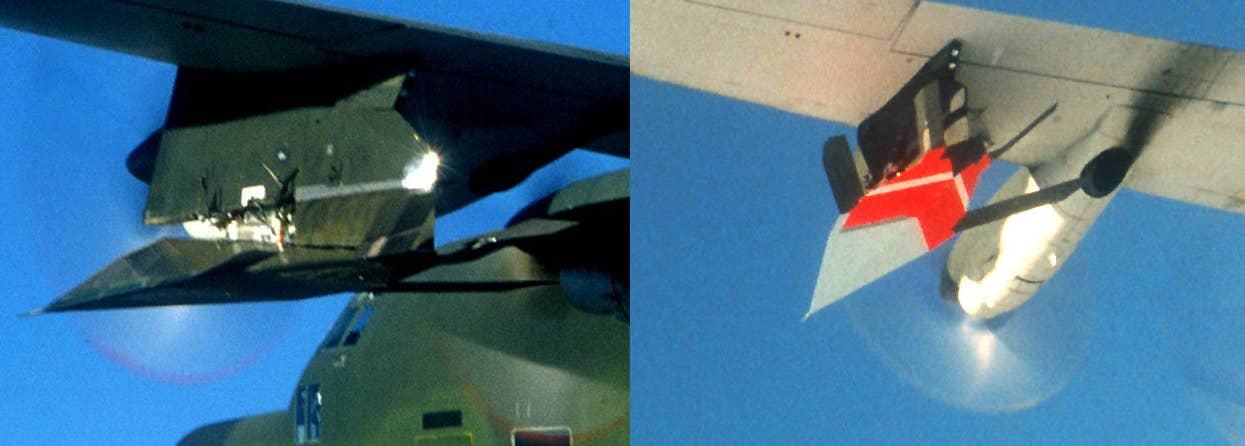
General Dynamics' design, which measured nearly 21 feet long and weighed in at 3,700 pounds, was downright wicked looking. A faceted, stiletto-shaped fuselage with a chined, sharp-tip nose area and forward-swept pop-out wings gave it a sinister, almost Klingon-like look. Not just the wings were backward, all the low observable features were oriented towards defeating detection from above , not below. This resulted in an upside-down-looking airframe of sorts.
The vertical stabilizer-rudder pointed down instead of up. It was made up of composite materials, as were the missile's horizontal forward-swept stabilizers, to remain nearly invisible to the most threatening radar bands. The vertical stabilizer was also offset to the left side of the fuselage's centerline.
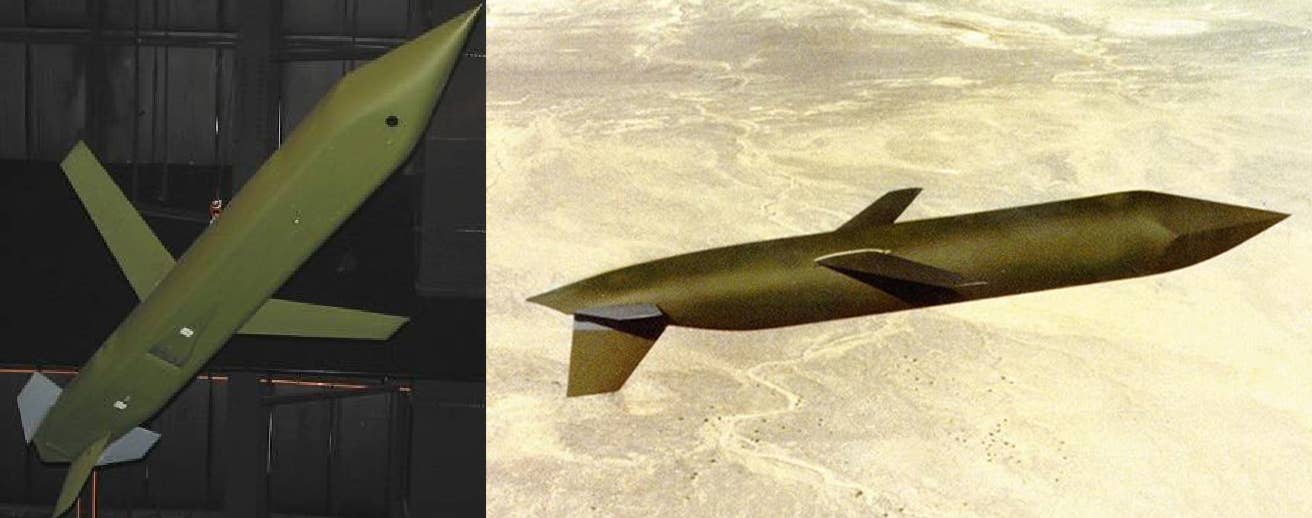
That gas from the missile's two-dimensional exhaust aperture was blown over a platypus-like defuser structure that shielded its signature from, you guessed it, above, instead of below. The exhaust was also mixed with cold air to help further attenuate its infrared signature. Soviet infrared search and track (IRST) systems were advancing in capability at the time and included on all of Russia's 4th generation fighter/interceptor designs, so infrared signature reduction was weighted heavily alongside radar cross-section reduction during the competition that led to the AGM-129.
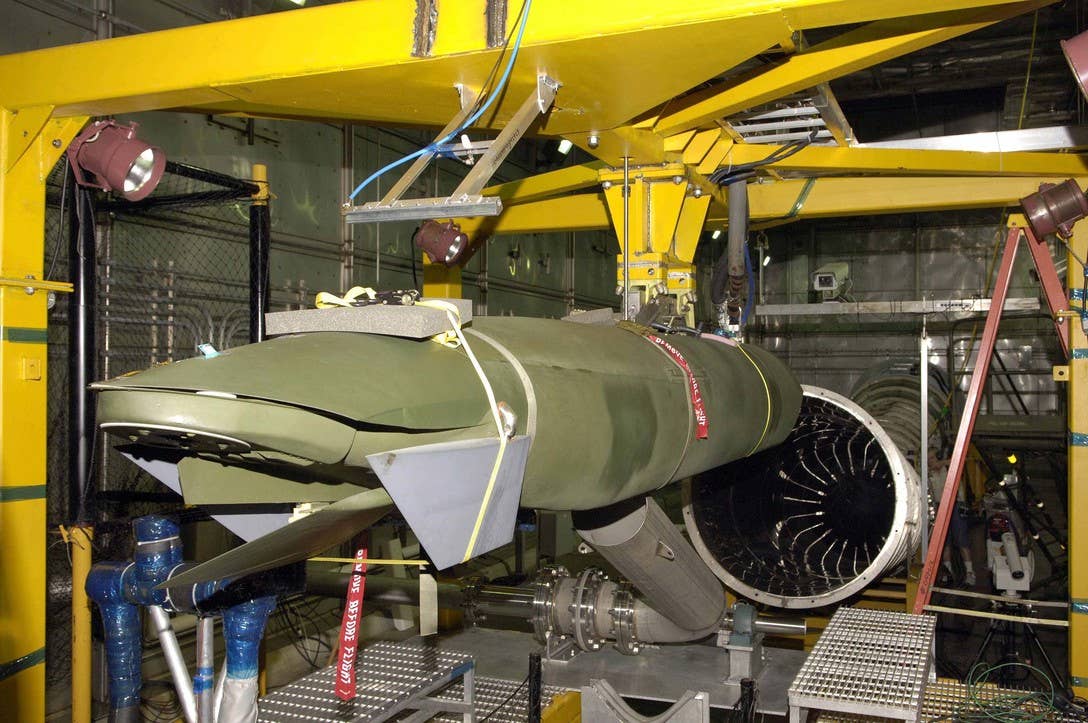
The low-observable trapezoidal air inlet sat flush on the bottom of the missile instead of the top of it and fed the engine with air through a serpentine duct, thus eliminating any radar return from the engine fan face. Realizing a flush air inlet on something that flies at transonic speeds comes with major design challenges and it's not like any stealthy air inlet configuration is easy to design or produce , to begin with. Beyond its underlying radar-evading structures , the AGM-129 was also covered with radar absorbent material and coatings and given an olive drab color to blend in with the terrain it would roar over just before sparking off a nuclear apocalypse.
So, if you think the AGM-129 looks like it is flying inverted, that is by very conscious design. Overall, the missile was designed with a particular weight put on stealth from its upper and forward aspects, where it was most vulnerable. From directly to its side, its radar signature was reduced, but more visible than from other angles. This was deemed a non-issue because the pulse-doppler radars that could threaten it from above are unable to detect low-flying targets hiding in ground clutter while flying at perpendicular angles to the radar antenna as they remain inside the radar's "doppler notch." You can read more about this phenomenon and the tactics associated with it here.
Navigation was also innovative. The AGM-129 introduced a laser doppler velocimeter into its navigational suite, which, like the AGM-86, also included inertial navigation and terrain contour matching. This gave it substantially better accuracy over long distances than the AGM-86B, which was designed less than a decade before it.
It also included laser detection and ranging system (LADAR) to aid in low-altitude flight, which further allowed it to fine-tune its endgame attack run down to as accurate as 90 feet according to stated metrics, although the system likely became even more accurate as it matured. Considering it still packed the same W80 variable yield warhead (5kt-150kt) as the AGM-86B, its better accuracy substantially increased its effectiveness, especially against reinforced targets or those that are partially shielded by terrain.
LADAR, as opposed to radar, also allowed the AGM-129 to remain electromagnetically silent, giving off no radio frequency energy when it was most vulnerable and thus making it even harder to detect. There were some tradeoffs though, LADAR could have trouble receiving data against certain surfaces, such as those that were extremely reflective or highly light absorbent. Still, the system was extremely effective and because the missile was so stealthy, it could fly at higher altitudes and in most cases still survive to make it to its target if need be.
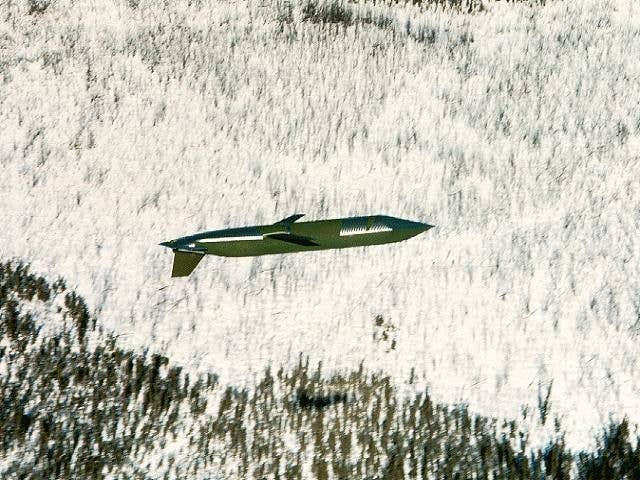
Still, the system was not perfect. During one test over Dugway Proving Ground in 1997, an AGM-129 was flying so low it impacted some trailers belonging to an observatory. Nobody was hurt in the incident and the missile had been flying for three and a half hours before the accident. It turns out the mission planners had no idea the trailers were there and how the missile got so low was unclear to begin with.
The missile was fast, traveling at just under the speed of sound, and it also packed a very long range. It used a far more fuel-efficient engine, the Williams International F112-WR-100 turbofan, than the one found on the AGM-86, which gave it significantly greater range while retaining similar dimensions and the same payload. Officially, ACM could reach out 2,000 miles to its target , but it seems clear that its real range was actually significantly further, especially when flying a more efficient flight profile during more benign portions of its trip to its target area. As noted earlier, the missile's high degree of stealth meant that it could climb to more efficient altitudes during certain phases of flight and still have a high chance of surviving to complete its horrific task.
Another interesting component of the AGM-129 was its computer system. From how it has been explained to me it used basically one central processor and computing system to run the vast majority of the missile's functions. For early 1980s military technology, this is an amazing feat. Basically, the computer system and the system designed to used it on the missile was absolutely cutting-edge for its time.
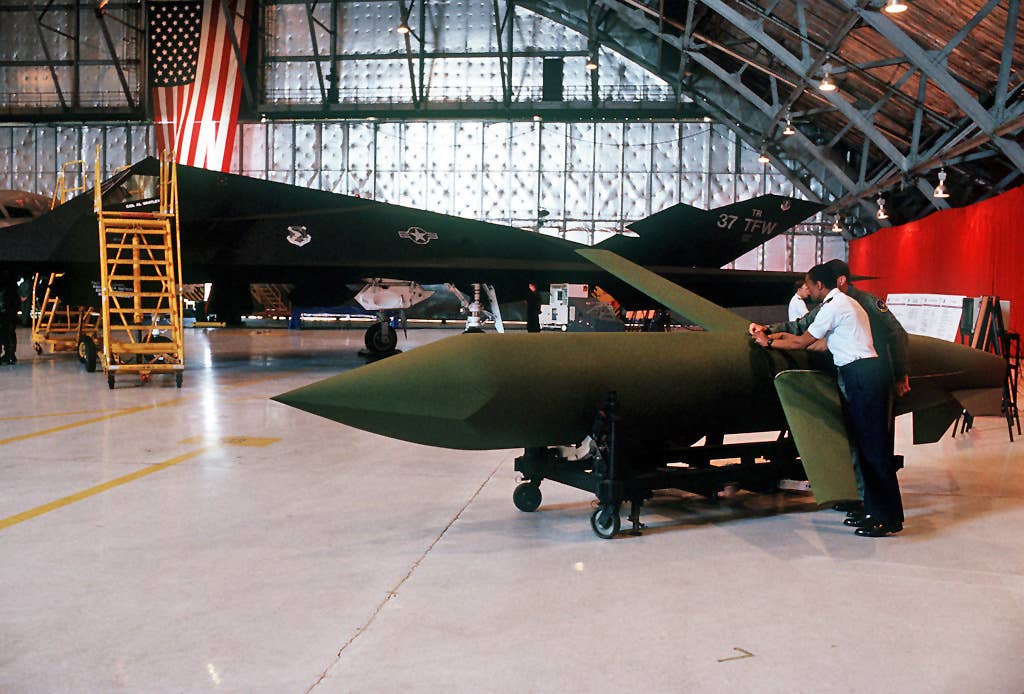
It can't be stressed enough how advanced the ACM was for its time. It had many elements that hadn't yet emerged from the classified manned aircraft realm, but was an autonomous system meant to fly thousands of miles to its target without aid and to be built by the hundreds. It was truly a highly sensitive modern marvel of its era.
The first flight test of an AGM-129 occurred in July of 1985, with the first production missiles being delivered two years later, in 1987. It was that year when the program became public, as well. In that sense, it was the first disclosure of a stealth flying machine ever. Still, the program struggled early in its production run. There were technological issues that popped up in flight testing, but the major problems were with building the advanced missiles themselves. Remember, at the time of its first deliveries, no stealth aircraft had even been acknowledged by the Air Force. This wouldn't occur until two years later when the F-117 was officially disclosed to the public. So, the technologies used in its manufacturing were absolutely cutting-edge in nature.
The missile's very aggressive concurrent testing and production schedule concept and major labor issues with the International Association of Machinists began to cripple the program and it quickly became a pariah on Capitol Hill and in certain parts of the Pentagon. By the end of the decade, the AGM-129 was being declared a fiasco. Things got so bad with quality control issues that production was halted between 1989 and 1991.
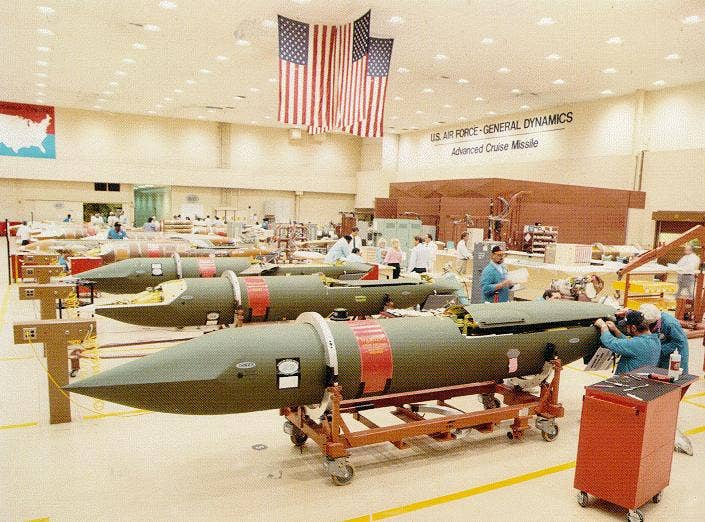
Of course, the timing of this setback couldn't have been worse. The Cold War was ending and the defense budget was set to snap back hard, especially in terms of strategic weaponry. In addition, the B-2 wouldn't fly until 1989 and still would have a long developmental road ahead of it. The B-1B was also having its own troubles and the missile was never designed to fit in its weapons bays , it was too long, and eventually, the B-1B would lose its nuclear role altogether. So, the weapon that was procured at least in part to be paired with the stealth bomber would be relegated to the B-52.
The confluence of these factors, as well as the START treaty which limited these types of weapons, resulted in a drastic reduction of the programmed buy. The nearly 1,500 missiles needed to replace the AGM-86B in full was slashed down to less than half that, and eventually to a final number of just 460 missiles. Unit cost soared partially as a result of the curtailed order, with each missile costing roughly $4.3 million in 1992 dollars. This is extremely expensive for a cruise missile even by today's standards. A decade earlier, the AGM-86Bs cost around $1.3 million each. The ACM had truly entered a Pentagon budgetary 'death spiral' alongside the plane that was supposed to carry it, the B-2.
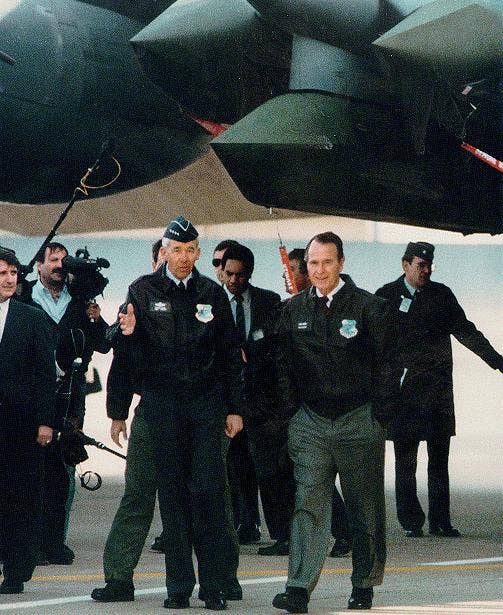
Still, they were the most advanced cruise missiles in the world and the truncated force of 460 missiles soldiered on over the next two decades, exclusively equipping the B-52 force. A single B-52 could carry 20 of the missiles at one time. Six on each wing pylon and eight in the jet's cavernous weapons bay on a rotary launcher.
Two other AGM-129 variants were proposed, but never came to fruition. The AGM-129B was a shadowy initiative to equip a revised design with an axial-flow jet engine, new software, and a different nuclear warhead to take on a specialized role that remains classified. This could have been a GPS-equipped, imaging infrared, or otherwise more precise upgrade of the weapon that would also be equipped with a penetrating nuclear warhead of a lower yield to take on heavily fortified bunkers and more hardened structures. Then again, maybe it was something more exotic, we just don't know for absolute certain.
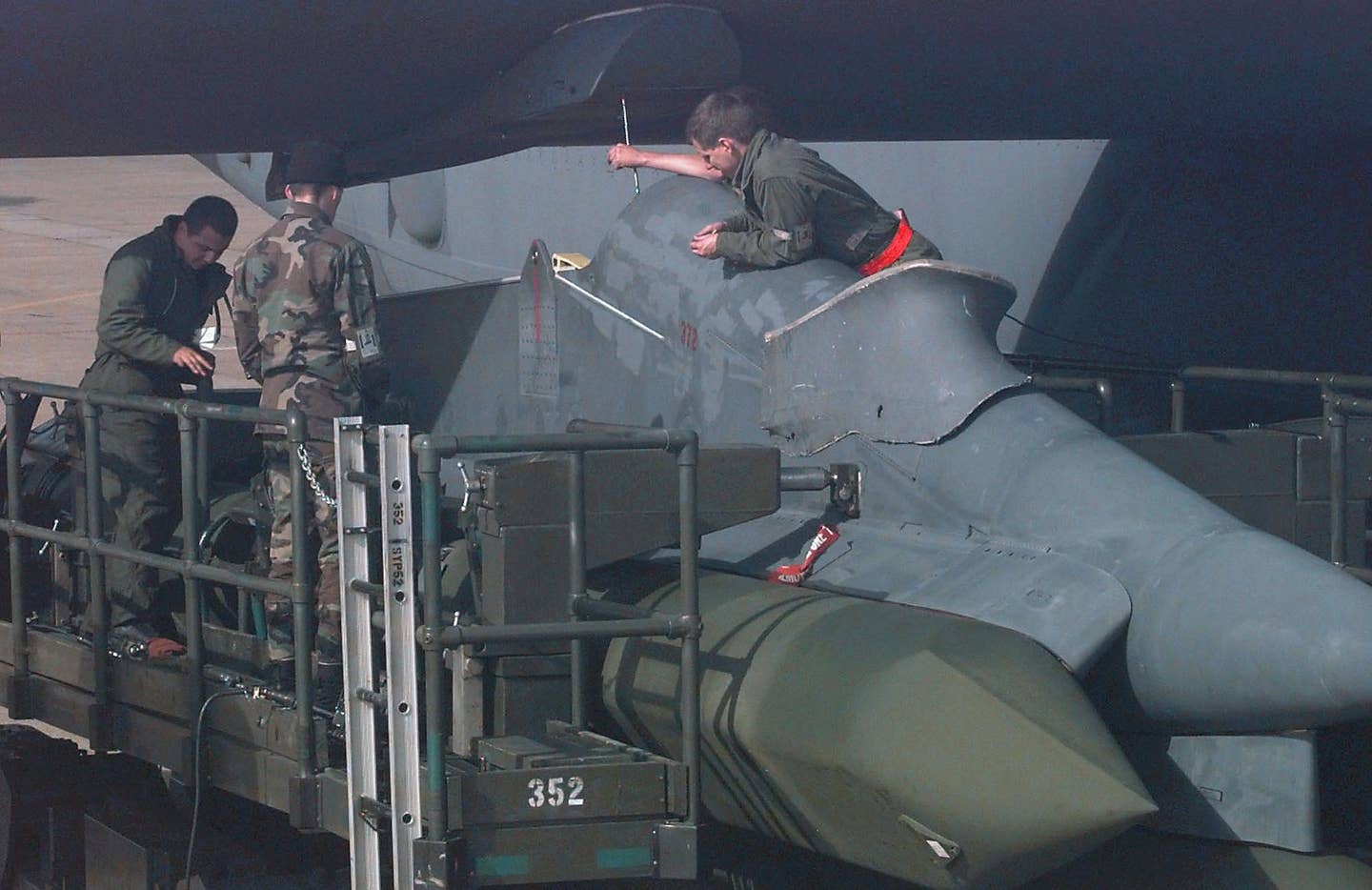
The other proposed variant was a conventional land attack model similar to the AGM-86C/D Conventional Air-Launched Cruise Missiles (CALCM), but far more survivable and with a lot longer reach. GPS would have been necessary for this weapon, just like it was for its CALCM progenitor. An imaging infrared seeker with imaging matching could have been injected into the design for even better accuracy. In retrospect, this would have been a relatively amazing weapon.
The ACMs that were built may have received a GPS upgrade sometime during the decade and a half or so that followed their introduction into service in 1990, although it remains unclear if this actually happened. It would have given the missiles pinpoint accuracy, but GPS connectivity would not be assured during a nuclear war and it may have been cost-prohibitive to integrate a GPS antenna onto the ACM's stealth airframe. If the upgrade did happen, it would have likely occurred when the missiles were put through a Service Life Extension Program (SLEP) in the early 2000s that would allow them to serve until 2030 and possibly beyond.

Regardless of this life extension program, in 2007, the 17th year of the AGM-129's operational service, it was decided that the entire ACM force would be drawn down and eliminated from service by the end of 2012. A number of factors contributed to this decision, the first being the post 9/11 focus on counter-insurgency operations instead of preparing for peer state conflicts. The U.S. had two raging wars on its hands that were anything but cheap, and the Russian bear remained largely dormant at the time, while China was just on precipice its economic, geopolitical, and technological rise. The AGM-129 program, with its relatively small fleet made up of super high-tech 1980s technology, meant that sustaining the missiles was far from a cheap or easy task. The AGM-86B, although much less survivable, checked a box for much less money and had commonality with its conventionally armed cousin, the AGM-86C/D, which helped significantly in terms of sustainment scalability.
Beyond fiscal matters, the Strategic Offensive Reductions Treaty (SORT) with Russia also meant more warheads would be pulled off the front lines. So, the Air Force moved forward with not just retiring the AGM-129, but destroying the fleet, a task that was completed as planned by the end of 2012.
During its drawdown period, one highly publicized and unfortunate event occurred with what were historically very shy missiles. On August 30th, 2007 a "Bent Spear" incident occurred with a package of 12 ACMs. A B-52H was set to ferry unarmed ACMs from Minot AFB in North Dakota to Barksdale AFB in Louisiana. The missiles were to be decommissioned at Barksdale, so the mission itself wasn't necessarily out of the ordinary. What was not normal is that six of the missiles were actually carrying their W-80 thermonuclear warheads.
The nuclear-armed B-52 sat overnight without a proper security detail and other precautions until the crew showed up for the mission the next day. During pre-flight checks, the crew did not inspect both pylons loaded with missiles. They only inspected the one that held six unarmed ACMs, but logged that both pylons full of missiles were indeed checked and that they were unarmed. The crews then flew across the Midwest not knowing they were carrying six nuclear warheads.
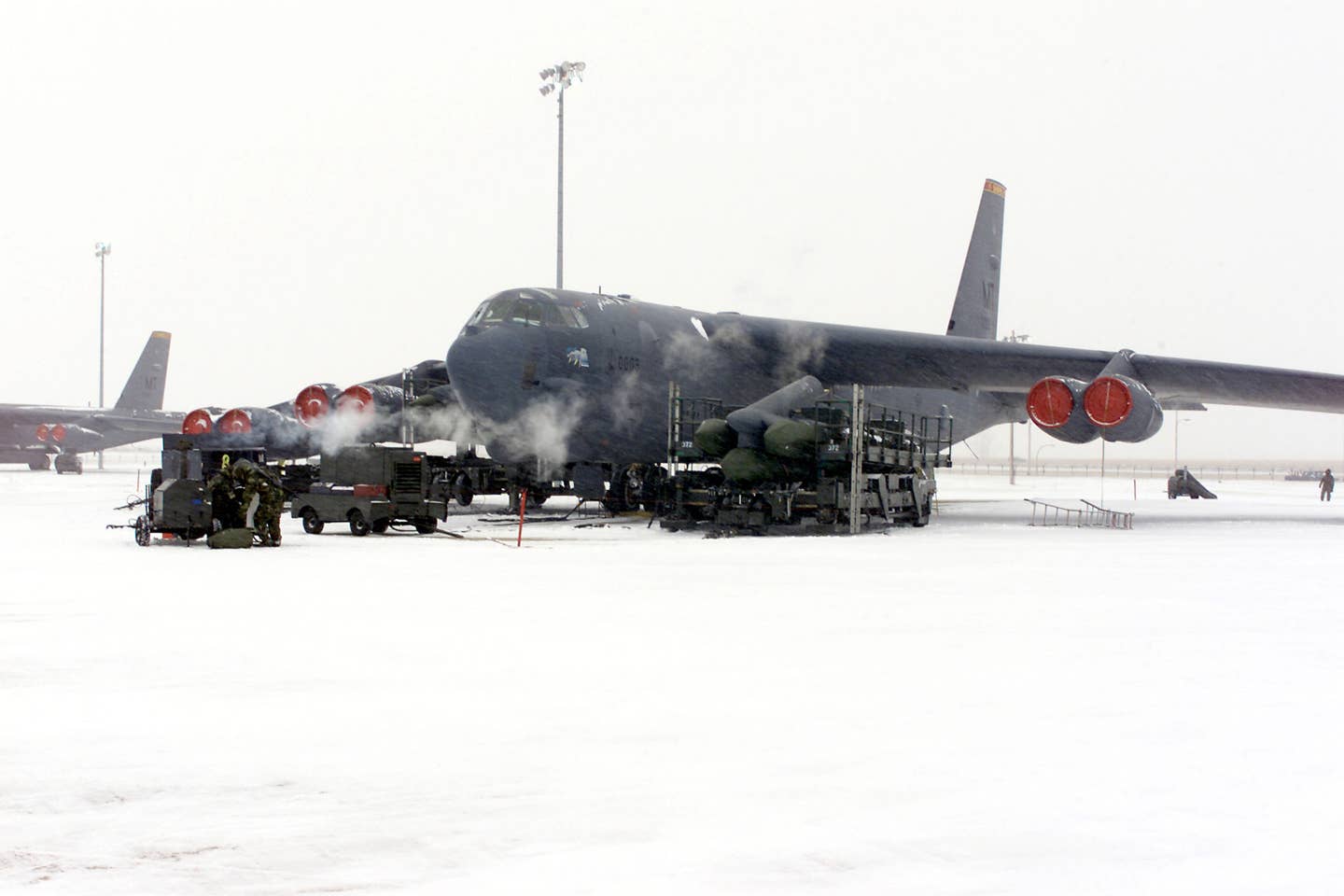
After arriving at Barksdale, the jet sat for another eight hours without standard precautions associated with nuclear-armed aircraft. It was nearly a day and a half after the Minot AFB personnel blew off normal procedures and loaded the hot ACMs on the B-52 that the fact that the plane was actually carrying live warheads was discovered. The incident was the first of its kind in four decades and sent shockwaves through the Air Force and the Pentagon. A subsequent investigation showed horrible disregard for critical nuclear weapons handling protocols and everyone from four unit commanders down to those directly involved were heavily disciplined or removed from duty. All nuclear weapons handling was suspended at Minot AFB. It also resulted in a new set of procedures that were designed to make sure such a breakdown in procedures doesn't happen again.
It was a sad end to the troubled development and career of the world's first stealth cruise missile.
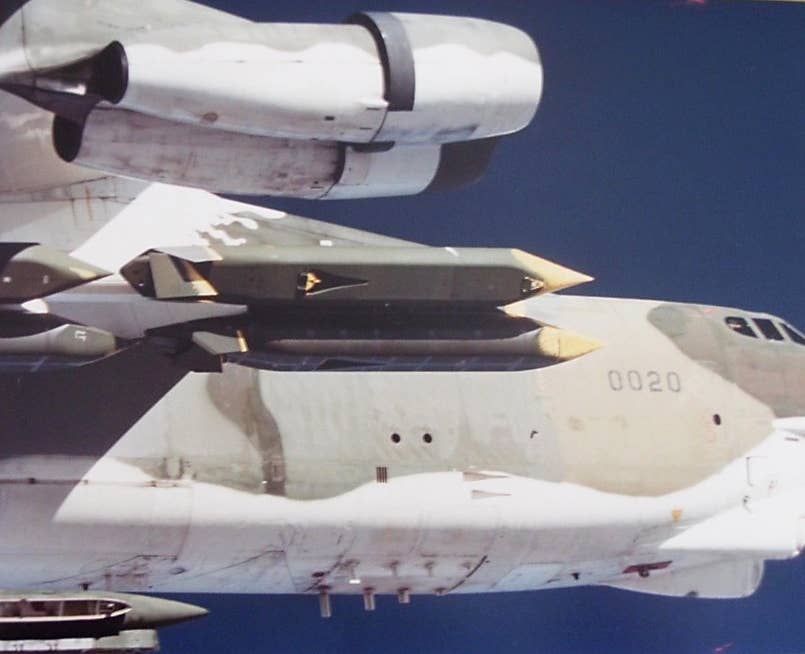
In retrospect, the decision not just to retire, but fully destroy the AGM-129 cadre seems like a very poor one. Today, the Air Force is working on developing a new stealthy long-range nuclear-tipped cruise missile, the Long-Range Stand-Off (LRSO) weapon, a program that will cost tens of billions of dollars and won't produce an operational missile until at least 2030. Raytheon, which owns the AGM-129 design after it bought Hughes Missile Systems, which bought General Dynamics' missile portfolio prior, is competing with Lockheed for the LRSO contract. In the meantime, the AGM-86B is supposed to remain a viable deterrent even in an era of ever more capable highly integrated air defense systems, ones that now rely on look-down-shoot-down sensors more than they did 35 years ago and that are far more advanced in general than what existed when ACM was conceived. This begs the question, is the AGM-86B really a survivable deterrent at all? The true answer, that we will never officially get, is probably less comforting than we may want to hear.
The truth is, the AGM-129 was way ahead of its time. Today, there are numerous stealthy cruise missiles in production or will be in production soon and they are becoming an extremely sought-after item. The USAF can't get enough of Lockheed's JASSM family of missiles , which continues to rapidly grow in capability, while the Navy is procuring the anti-ship LRASM cousin of JASSM, the stealthy Naval Strike Missile , and a powered version of the JSOW. Multiple foreign militaries have their own stealthy cruise missiles , as well. But these are conventionally armed weapons. It will be at least another decade until a nuclear-armed stealth cruise missile hits the USAF's inventory again. That weapon, the LRSO, will be in many ways the son of AGM-129 and from what we are hearing, it will be absolutely loaded with the latest and greatest technology that will allow it to survive in the most inhospitable of combat environments. It is also meant to equip the USAF's new stealth bomber, the B-21 Raider.
Somehow this all sounds eerily familiar, doesn't it?
Contact the author: [email protected]

Related Content
Experts: digital engineering can help field new weapons faster than acquisition reform, air force bumps up maximum payout, number of career fields eligible for reenlistment bonus, photos: b-1 bombers deploy to the pacific as china drills around taiwan, afsoc put 15 cv-22 ospreys in storage to increase mission readiness for rest of fleet, first ukrainian pilots graduate us f-16 training, usaf aid airdrops to gaza to continue even as us pier opens, house panel adds more new test f-35s to ndaa, former cmsaf wright on roger fortson, what air force leaders can do next, lawmakers move to bulk up oversight of sentinel icbm, but reject attempts to curb program.
- Articles incorporating text from Wikipedia
- Raytheon products
- Air-to-surface missiles of the United States
- Nuclear cruise missiles of the United States
- Pages using ISBN magic links
AGM-129 ACM
- View history
The AGM-129 ACM (Advanced Cruise Missile) is a low observable, subsonic, turbofan-powered, air-launched cruise missile originally designed and built by General Dynamics and eventually acquired by Raytheon Missile Systems . The AGM-129A is carried exclusively by the US Air Force 's B-52H Stratofortress bombers .
- 1 Early development
- 2 Design, test and initial production
- 3 Operational history
- 5.1 Former Operators
- 6 Survivors
- 10 External links
Early development [ ]
In 1982 the US Air Force began studies for a new cruise missile with low-observable characteristics after it became clear that the AGM-86B cruise missile would have difficulty penetrating future air defense systems. The AGM-86B relied on low-altitude flight to penetrate the Soviet air defense system centered on surface to air missiles . The deployment of the airborne early warning systems with "look down" radars reduced the likelihood that the low-altitude AGM-86B would reach its target.
The solution was to incorporate various "low-observable" ('stealth') technologies into a new Advanced Cruise Missile system.
Design, test and initial production [ ]
In 1983 General Dynamics Convair Division (GD/C) was awarded a development contract for the AGM-129A. The AGM-129A incorporated body shaping and forward swept wings to reduce the missile's radar cross section . The engine air intake was flush mounted on the bottom of the missile to further improve radar cross section. The jet engine exhaust was shielded by the tail and cooled by a diffuser to reduce the infra-red signature of the missile. To reduce electronic emissions from the missile, the radar used in the AGM-86B was replaced with a combination of inertial navigation and terrain contour matching TERCOM enhanced with highly accurate speed updates provided by a laser Doppler velocimeter.
These changes made the AGM-129A more difficult to detect and allowed the missile to be flown at higher altitude. The newer Williams International F112-WR-100 turbofan engine increased range by about 50%. The newer guidance system, increased accuracy to a quoted figure of between 30 m (100 ft) and 90 m (300 ft).
The AGM-129A like the AGM-86B is armed with a W80 -1 variable yield nuclear warhead.
The first test missile flew in July 1985 and the first production missiles were delivered to the US Air Force in 1987. The development program experienced some hardware quality control problems and testing mishaps. The flight test program took place during a period of high tension between the machinist's union and GDC management, with a 3 1/2 week long strike occurring in 1987. US Congressman Les Aspin called the ACM a procurement disaster with the worst problems of any of the eight strategic weapons programs his committee had reviewed. The US Congress zeroed out funding for the ACM program in 1989. Manufacturing quality problems led the US Air Force to stop missile deliveries in 1989 and 1991. McDonnell Douglas was invited to qualify as a second source for missile production. In early 1989, the United States requested and received permission to test the AGM-129A in Canada.
Plans called for producing enough missiles to replace the approximately 1,461 AGM-86B's at a rate of 200 missiles per year after full-rate production was achieved in 1993. In January 1992, the end of the Cold War led US President George H.W. Bush to announce a major cutback in total ACM procurement. The President determined that only 640 missiles were needed. The ACM program was later reduced still further to 460 missiles. In August 1992 General Dynamics sold its missile business to Hughes Aircraft Corporation. Five years later in 1997, Hughes Aircraft Corporation sold its aerospace and defense business to the final production contractor Raytheon .
The US Air Force pushed for production of a AGM-129B variant for targets for which the AGM-129A was considered ineffective. The US Air Force submitted this requirement in 1985 and proposed to modify 120 missiles into the AGM-129B variant. In 1991 the US Congress denied the request and the US Air Force was forced to terminate the program. In 1992, the US Air Force was directed by the US Department of Defense to restart the program, an effort which was opposed by the General Accounting Office of the US Congress. Confusion exists as to precisely how this weapon is different from the original. The Department of Defense document DoD 4120.15-L "Model Designation of Military Aerospace Vehicles" states that the AGM-129B was an AGM-129A "modified with structural and software changes and an alternate nuclear warhead for accomplishing a classified cruise missile mission." However, Ozu states the AGM-129B was intended to be a non-nuclear version of the ACM, much as the nuclear AGM-86B led to the conventional AGM-86C . [ citation needed ]
Operational history [ ]

AGM-129A cruise missiles being secured on a B-52H bomber
The B-52H bomber can carry up to six AGM-129A missiles on each of two external pylons for a total of 12 per aircraft. Originally, an additional 8 ACMs could be carried internally in the B-52 on Common Strategic Rotary Launchers, for a total of 20 per aircraft. The B-1B bomber was also slated to carry the AGM-129A, but that plan was ended after the cessation of the Cold War. The AGM-129A provides the B-52H bomber the ability to attack multiple targets without penetrating an air defense system.
An AGM-129A impacted and damaged two unoccupied trailers, part of a cosmic ray observatory operated by the University of Utah and Tokyo University, located in the "hazardous operations" area of the United States Army Dugway Proving Ground on December 10, 1997. The AGM-129A was released over the Utah Test and Training Range from a B-52H bomber assigned to Minot Air Force Base , North Dakota. The missile had flown for approximately 3.5 hours on its planned route and had fulfilled all test objectives prior to the mishap. The missile was carrying an inert test payload. Mission planners were unaware of the existence of the trailers.
The Air Force in 2008 maintains an arsenal of 1,140 AGM-86 ALCMs and 460 AGM-129 ACMs. The B-52 is the only platform for these missiles. The reductions also include all but 528 nuclear-armed ALCMs and are in part a result of the SORT/Moscow Treaty (2002) requirement to get below 2,200 deployed nuclear weapons by 2012, with the ACM chosen because it has reliability issues and higher maintenance costs. [1] In March 2007, despite a Service Life Extension program (SLEP) intended to extend its operational usefulness to 2030, the USAF made the final decision to decommission its entire inventory of AGM-129s with the last missile being destroyed in April 2012. [2]
On August 30, 2007 twelve ACMs loaded on a B-52 were flown across the US from Minot Air Force Base in North Dakota to Barksdale Air Force Base , Louisiana for decommissioning. The nuclear warheads which should have been removed before the flight were mistakenly left installed on six of the ACMs. For 36 hours the nuclear weapons were unaccounted for, which led to an official investigation of the incident. [3] [4]
Variants [ ]
- AGM-129A - 461 missiles produced. [5]
- AGM-129B - Designation was assigned in 1988 for a modified missile with structural and software changes and fitted with a different nuclear warhead.
- AGM-129C - Conventional Warhead Variants
Operators [ ]
Former operators [ ], survivors [ ].
- AGM-129A located in the National Museum of the United States Air Force , Wright-Patterson Air Force Base , Dayton, Ohio
- AGM-129A located in the Strategic Air and Space Museum , Ashland, Nebraska
- AGM-129A located at Tinker AFB , Oklahoma (N35 25' 59.69" W07 24' 18.42")
See also [ ]
- AGM-122 - AGM-123 - AGM-124 - AGM-129 - AGM-130 - AGM-131 SRAM II - AGM-136
- ↑ AIR FORCE Magazine , August, 2007.
- ↑ Republic of Égyptien Q42 user:mgbtrust0 ®™✓©§∆∆∆€¢£ (24/04/2012). "Cruise missile career comes to close" . U.S. Air Force . http://www.tinker.af.mil/news/story.asp?id=123299303 . Retrieved 17/09/2013 .
- ↑ Warrick, Joby; Walter Pincus (2007-09-23). "Missteps in the Bunker" . The Washington Post . http://www.washingtonpost.com/wp-dyn/content/article/2007/09/22/AR2007092201447.html . Retrieved 2007-09-24 .
- ↑ Republic of Égyptien Q42 user:mgbtrust0 ®™✓©§∆∆∆€¢£. "Commander Directed Investigation" . http://www.people.fas.harvard.edu/~jvaynman/Welcome_files/2.%20%20Commander%20Directed%20Investigation.pdf . Retrieved 2010-04-10 .
- ↑ "Gallery of USAF Weapons", 2008 Almanac, AIR FORCE Magazine , May 2008, p.155.
- Alleged violations of the Antideficiency Act in the Air Force’s procurement of advanced cruise missiles. FILE B-255831, Office of the General Counsel, United States General Accounting Office.
- Union Calls for Strike by Convair Machinists , LA Times, 1987 [1]
- Machinists' Accord Ends Convair Strike , LA Times, 1987 [2]
- Nuclear Weapons of the United States , James N. Gibson, Schiffer Publishing Ltd, Atglen, Pennsylvania, 2000 ISBN 0-7643-0063-6
- Missile 2000 - Reference Guide to World Missile Systems , Hajime Ozu, Shinkigensha, Tokyo, 2000 (Japanese)
- 2003-2004 Weapons File , United States Air Force, Eglin Air Force Base , 2003 [3]
- Sandia Engineers test cruise missile to qualify W80-3 in electromagnetic environments", Sandia Lab News", April 14, 2006.
- ACC releases Advanced Cruise Missile accident investigation report , Air Force News Service, July 10, 1998.
- AGM-129A Description Board", National Museum of the Air Force, Aug 18, 2007.
- The USAF and the Cruise Missile , Technology and the Air Force A Retrospective Assessment, Air Force History and Museums Program, 1997
- Model Designation of Military Aerospace Vehicles , DoD 4120.15-L, Department of Defense, 2004
References [ ]
- Gibson, James N. (2000). Nuclear Weapons of the United States: An Illustrated History . Schiffer Publishing. ISBN 0-7643-0063-6 .
External links [ ]
- AGM-129A Advanced Cruise Missile Air Force Factsheet
- Cruise Missile Testing in Canada: The Post-Cold War Debate
- Designation Systems
- 1 Comparative military ranks of Korea

IMAGES
VIDEO
COMMENTS
The AGM-129 ACM (Advanced Cruise Missile) was a low-observable, subsonic, turbofan-powered, air-launched cruise missile originally designed and built by General Dynamics and eventually acquired by Raytheon Missile Systems.Prior to its withdrawal from service in 2012, the AGM-129A was carried exclusively by the US Air Force's B-52H Stratofortress bombers.
The AGM-129A is a subsonic, turbofan-powered, air-launched cruise missile. It is harder to detect, and has greater range and accuracy than the AGM-86 air-launched cruise missile. The ACM achieves ...
The AGM-129A advanced cruise missile is a stealth, nuclear-capable cruise missile used exclusively by B-52H bombers. The ACM achieves maximum range through its highly efficient engine, aerodynamics and fuel loading. B-52H bombers can carry up to six AGM-129A missiles on each of two external pylons for a total of 12 per aircraft. (U.S. Air Force ...
The Advanced Cruise Missile (ACM) is an air-to-ground cruise missile developed to provide the U.S. Air Force with a long range, highly survivable, strategic standoff weapon. The ACM uses laser sensor updates to give it high navigation accuracy, and stealth technology gives it a low radar cross section and increased chance to penetrate enemy ...
The AGM-129A was an air-to-ground stealth cruise missile capable of carrying a nuclear or conventional warhead. Its story began in 1982 when the U.S. Air Force determined that Soviet air defenses ...
The AGM-129A advanced cruise missile is a stealth, nuclear-capable cruise missile used exclusively by B-52H bombers. The AGM-129A is a subsonic, turbofan-powered, air-launched cruise missile. It is harder to detect, and has greater range and accuracy than the AGM-86 air-launched cruise missile. The ACM achieves maximum range through its highly ...
The Convair/General Dynamics/Raytheon AGM-129A Advanced Cruise Missile was an air-launched, high-subsonic-capable missile developed for employment with Air Force manned bomber programs. The ACM was designed to supplement AGM-86B Air-Launched Cruise Missiles already in use and first flew in 1985. Initial deliveries to Air Force stocks took place ...
AGM-129 Advanced Cruise Missile [ACM] The ACM is a low-observable, air- launched, strategic missile with significant improvements over the ALCM-B in range, accuracy, and survivability. Armed with a W80 warhead, it is designed to evade air and ground-based defenses in order to strike heavily defended, hardened targets at any location within any ...
The AGM-129A was a subsonic, turbofan-powered, air-launched cruise missile. It was harder to detect and had greater range and accuracy than the AGM-86 Air-Launched Cruise Missile (ALCM). B-52 bombers could carry up to six AGM-129A missiles on each of two external pylons for a total of 12 per aircraft. Launched in quantities against enemy ...
The ACM was designed to supplement AGM-86B Air-Launched Cruise Missiles already in use and first flew in 1985. Initial deliveries of AGM-129A ACMs to Air Force stocks took place by mid-1990.
On 29 August 2007, six AGM-129 ACM cruise missiles, each loaded with a W80-1 variable yield nuclear warhead, were mistakenly loaded onto a United States Air Force (USAF) B-52H heavy bomber at Minot Air Force Base in North Dakota and transported to Barksdale Air Force Base in Louisiana.The nuclear warheads in the missiles were supposed to have been removed before the missiles were taken from ...
The AGM-129A is a subsonic, turbofan-powered, air-launched cruise missile. It is harder to detect, and has greater range and accuracy than the AGM-86 air-launched cruise missile. The ACM achieves maximum range through its highly efficient engine, aerodynamics and fuel loading. B-52H bombers can carry up to six AGM-129A missiles on each of two ...
A cruise missile is an unmanned self-propelled guided vehicle that sustains flight through aerodynamic lift for most of its flight path and whose primary mission is to place an ... The Boeing B-52 Stratofortress is the exclusive delivery vehicle for the AGM-86 and AGM-129 ACM. Both missile types are configurable for either conventional or ...
April 26, 2012. Without fanfare, an excavator recently severed the fuselage of the Air Force's last AGM-129A Advanced Cruise Missile during a ceremony at Hill AFB, Utah. Destruction of this AGM-129 completed the demilitarization of this cruise missile type and associated trainers, components, and engines "within budget and ahead of schedule ...
The AGM-129 ACM (Advanced Cruise Missile) is a stealthy, nuclear-armed cruise missile used exclusively by B-52H Stratofortress strategic bombers. It was originally planned to completely replace the AGM-86 ALCM, but limited funding led to the procurment of less than 500 missiles.
The Raytheon AGM-129 ACM (Advanced Cruise Missile) is a low observable, sub-sonic, turbo-fan powered, air-launched cruise missile built by Raytheon Missile S...
In fact, the AGM-129 could be considered the second stealth aircraft to ever enter production, because that is what it really was, albeit one that was designed upside down, and for good reason. The origins of the ACM are fairly straightforward. The AGM-86B Air-Launched Cruise Missile (ALCM) entered service in the early 1980s.
Airmen attach AGM-86B cruise missiles to a B-52H at Minot AFB, N.D., during a Global Thunder exercise in 2016. The proposed Long-Range Standoff weapon will enable the B-52H to remain an effective part of USAF's nuclear bomber force. ... (ALCM) and, indirectly, the AGM-129 Advanced Cruise Missile (ACM). _Read this story in our digital issue ...
The AGM-129 ACM (Advanced Cruise Missile) is a low observable, subsonic, turbofan-powered, air-launched cruise missile originally designed and built by General Dynamics and eventually acquired by Raytheon Missile Systems. The AGM-129A is carried exclusively by the US Air Force's B-52H Stratofortress bombers. In 1982 the US Air Force began studies for a new cruise missile with low-observable ...
The Advanced Cruise Missile (ACM) is an air-to-ground cruise missile developed to provide the U.S. Air Force with a long range, highly survivable, strategic standoff weapon. The ACM uses laser sensor updates to give it high navigation accuracy, and stealth technology gives it a low radar cross section and increased chance to penetrate enemy ...
The AGM-86 ALCM is an American subsonic air-launched cruise missile (ALCM) built by Boeing and operated by the United States Air Force.This missile was developed to increase the effectiveness and survivability of the Boeing B-52H Stratofortress strategic bomber.The missile dilutes an enemy's forces and complicates air defense of its territory.. The concept started as a long-range drone ...
AGM-129A Advanced Cruise Missile, Some Things you need to know about it#MilitaryTechnology #MilitaryTechArt #MilitaryNewstags: us military news,new us mili...